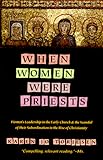Originally written in the late ’90s regarding the reading list of a truly fascinating anthropology class. The papers are extremely light — basically just some quick review and discussion questions. I include them here mostly because the books were excellent and well worth reading for thoughtful perspectives on women’s roles in a variety of religions.
Dharma’s Daughters: Contemporary Indian Women and Hindu Culture
by Sara S. Mitter
(Literal translation of dharma: “morality.”)
I think the most puzzling new concept for me in this week’s reading was the often-mentioned but never explained need for women to marry. Why was it so necessary for 17 year old Gouri to marry – and yet she then promptly left her husband? Why was 21 year old Tanya still unmarried? What do the married women fear from unmarried women? Do the men fear unmarried women too?
Also, I’d be interested in discovering both how upper class Indian women can simply not see lower class women (as shown by Vimla on the train)… and in exploring what it is that I, as a comfortable middle class woman, do not see in my own culture. Furthermore, I’d be curious to see if that selective blindness is tied to a particular chronological age (since Kamla saw the lower class women), or perhaps to a different cultural viewpoint. Is that part of what “westernization” does, or was it merely the curiosity of youth? Will Kamla eventually lose the ability to “see” lower class women?
I found the inability to “connect” between the upper and lower class women rather sad. It is disheartening to see women being the instruments of their own continued suppression, when if they worked together they could accomplish so much more. This situation is not confined just to India, either – the same problem exists in America too, between women of color and white women. Unfortunately I’m not really sure how this could be remedied. However, I’m quite interested to see if religion could be used to accomplish this goal. After all, it’s certainly been used frequently to keep barriers between women up.
Later edit: I was later informed every menstruation cycle experienced by an unmarried girl living in her parents’ home was considered a temptation and invitation to demons, and a source of very bad luck — thus the need to marry off one’s girl children before they started menstruating.
This is, of course, not believed by all Hindus, any more than all Americans believe female virginity is a necessity for marriage. The cultural practices remain, however (e.g., girl children are quickly married off, or brides wear white), even if the ‘reasoning’ behind them is no longer relevant.
From the Margins of Hindu Marriage: Essays on Gender, Religion & Culture.
edited by Lindsey Harlan and Paul B. Courtright [paper I]
This week’s reading was the first 4 chapters of From the Margins of Hindu Marriages. I understand the concept of reviewing the hegemonic norm by approaching it through the discourse of marginality. However, for all that the varieties of marginal discourse presented a wide spectrum of voices, I still found myself depressedly wondering what the point was – the hegemonic ideal being reviewed seemed just too big and too immovable for it to be understood on any terms but its own. Are these voices from the margin really contributing to the understanding of the hegemonic concept of Hindu marriage? Or are they merely sad little wails from the tiny and un-developed ‘wilderness’ of counter-hegemonic thought, doomed to be crushed and ignored by the culture’s powerful and overwhelming concept of what marriage should be?
Indeed, the strongest impression I received from these readings was the hopelessness of attempting to defy or thwart the inward-turned, closed, self-supporting structure of Indian culture. Is it really possible to only re-interpret part of it, as the bhakti (literal translation: “religious devotion,” used in this case to denote women that are religiously ‘inspired’ or ‘called.’) all attempted to do — and all failed to accomplish? Or in order to re-define one’s self, must one defy all of it? Must one deny one’s birthright and heritage and life-long training? How is lasting social change to be accomplished here? Changing the laws certainly isn’t doing it. Obviously some social change is desired by some subsets of the people, or we wouldn’t have the examples delineated in the book.
I think what impressed me the most about these readings was the lack of agency most women seem to have today. True, they individually negotiate for small triumphs. However, ultimately most of these triumphs are inter-personal, and of limited duration.
Other Excellent & Recommended Books from this Course
 Fundamentalism and Gender
Fundamentalism and Gender
edited by John Stratton Hawley
 When Women Were Priests: Women’s Leadership in the Early Church and the Scandal of Their Subordination in the Rise of Christianity
When Women Were Priests: Women’s Leadership in the Early Church and the Scandal of Their Subordination in the Rise of Christianity
by Karen Jo Torjesen



